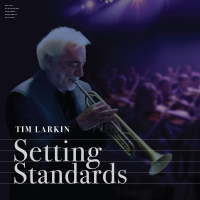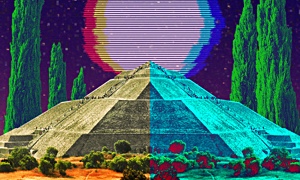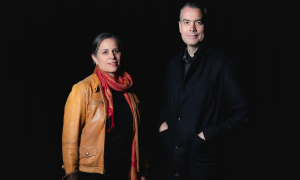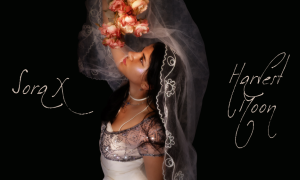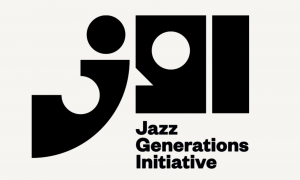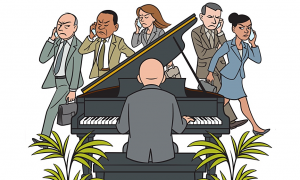104 East 126th Street
New York, NY 10035
212 348-8300
http://www.jazzmuseuminharlem.org/
Living Legend Hank Jones at Harlem Speaks
Hank Jones, Pianist
June 29, 2006
One of world's greatest pianists, Hank Jones, is the special guest of Harlem Speaks on June 29, 2006. Born Henry W. Jones in 1918 in Mississippi, but raised in Pontiac, Michigan, Jones received classical piano training from Charlotte Franzell during his childhood.
By the age of 13, he was already performing with territory bands, and by 1944 he moved to New York at the recommendation of Lucky Thompson, to join the band of Hot Lips Page, with whom he made his first recordings for the Continental label.
While freelancing with Andy Kirk, Billy Eckstein, John Kirby, Coleman Hawkins and Howard McGhee, Jones developed his own style. Freely mixing the newer idioms of Bud Powell and Al Haig with that of his main mentor, Art Tatum, Jones rose quickly to the top shelf of jazz pianists.
In late 1947, he joined the Jazz at the Philharmonic, and from 1948 to 1953 he became the pianist for Ella Fitzgerald. During this period Jones also made several recordings for Norman Granz's various labels, including historical sessions with Charlie Parker and Lester Young. After leaving Ella, he formed a steady rhythm section with Barry Galbraith, Milt Hinton and Osie Johnson. This unit recorded with some of the finest talent in New York at the time, like Roy Eldridge, Lionel Hampton, Milt Jackson, Rex Stewart and many others.
After several years as a freelance player, including a brief stay with Benny Goodman (1956) and Artie Shaw, Jones joined the staff of CBS records, where he stayed for the next seventeen years, until the staff was disbanded in 1976. During this period he worked with large studio bands, performing on some of the top radio and TV programs, such as the Ed Sullivan Show, but continued to lead jazz groups (mostly trios) through the eighties, showcasing the talents of Ron Carter, Buster Williams, or George Duvivier on bass and Tony Williams, Al Foster, or Oliver Jackson on drums. His recordings fronting The Great Jazz Trio were multi-awarded in Japan, where he is almost a “national hero". During this period, Jones also did important duo recordings with fellow pianist Tommy Flanagan.
During the nineties Jones has been leading his own trios featuring some of the finest young musicians in the world, like drummers Marvin “Smitty" Smith, Lewis Nash or Kenny Washington, and bassists like Ray Drummond and George Mraz. His music is in great demand as the years go by, and he does an average of 70 concerts a year overseas, mostly in Japan and Europe, on top of his busy agenda at home.
Hank Jones is regarded today as the father of contemporary Jazz piano, and his influence can be heard in the work of most every jazz pianist in the world: the so-called Detroit Piano School is, in fact, the Hank Jones School, and musicians such as Barry Harris, Kenny Barron or Tommy Flanagan regard Hank Jones as a strong influence on their careers.
The June 8, 2006 guest, Olu Dara, was greeted by many fans and admirers, who came to hear the free-spirited multi-instrumentalist discuss his life and career.
And spirited the conversation was, in many ways. With deep humor he talked about his upbringing in various small towns in Mississippi, where his family tilled the fields as farmers. The oldest of seven, Olu began playing clarinet and performing for audiences at the age of 7. In addition to the customary blues of the deep South, he recalled hearing opera, and his father sang in a style reminiscent of Paul Robeson.
Olu was introduced to the cornet by an unlettered gentleman who, in almost mythological fashion, showed up in his small town one day and asked for a place to stay. His family obliged, and the man--who spoke six languages and played just about every instrument--began to teach him to play cornet.
He told Olu to blow into the mouthpiece as if he were blowing into a balloon. Once he got that down, he had Olu attach the remainder of the horn and form tones. Soon thereafter, the auto-didact genius played what turned out to be the bridge to Ellington's “Sophisticated Ladies" and told Olu to play it. He did.
The next day he showed Olu the sheet music to the tune, a brilliant introduction to sight reading, and Olu understood immediately.
Although Harlem Speaks is a discussion series, Olu performed by singing and humming tunes significant to his development as a musician. For instance, he recalled hearing Lee Morgan on John Coltrane's Blue Train recording as a college student, which changed him forever. “I felt as if I knew Morgan," he recalled.
He even stood up and did the hambone of his young days, performing for white folks for some change.
A very poignant moment when he mentioned his grandmother's singing while holding him on her lap. After Greg Thomas, the interviewer, asked him to sing in his grandmother's style, he hesitated. “I thought this was supposed to be just an interview, not a performance," he joked. But then he closed his eyes, and began humming and moaning and brought the spirit and memory of his grandmother to the proceedings.
Suddenly, struck by the memory, he put his hands to his face and began to weep.
For the next two hours he recalled his college days at Tennessee State University, leaving there before graduating and entering the Navy for four years, traveling the world on “secret missions," coming to New York and Harlem, beginning his family, and playing with Art Blakey and the Jazz Messengers in the early '70s. “Blakey was a master, the best band leader I've ever had. I found my voice, my identity with him because he gave me the freedom to be myself."
As did choreographer Diane McIntyre, who simply told him to play the piano one day, not even asking he if knew how. She believed in him implicitly.
After playing with Blakey Olu began playing so-called “free jazz," but was brought back down to earth one day when his son, Nas, then 7 years young, said: “Daddy, that sounds like background for a horror film." From that point on, he stayed firmly within the groove of his own unique mix of blues, jazz, and sounds from music across the world.
The bi-weekly Harlem Speaks series is produced by the Jazz Museum in Harlem's Executive Director, Loren Schoenberg, Co-Director Christian McBride, and Greg Thomas Associates, and takes place at the offices of the Jazz Museum in Harlem, located at 104 East 126th Street, between Park and Lexington Avenues, from 6:30pm-8:00+pm.
For more information contact All About Jazz.







